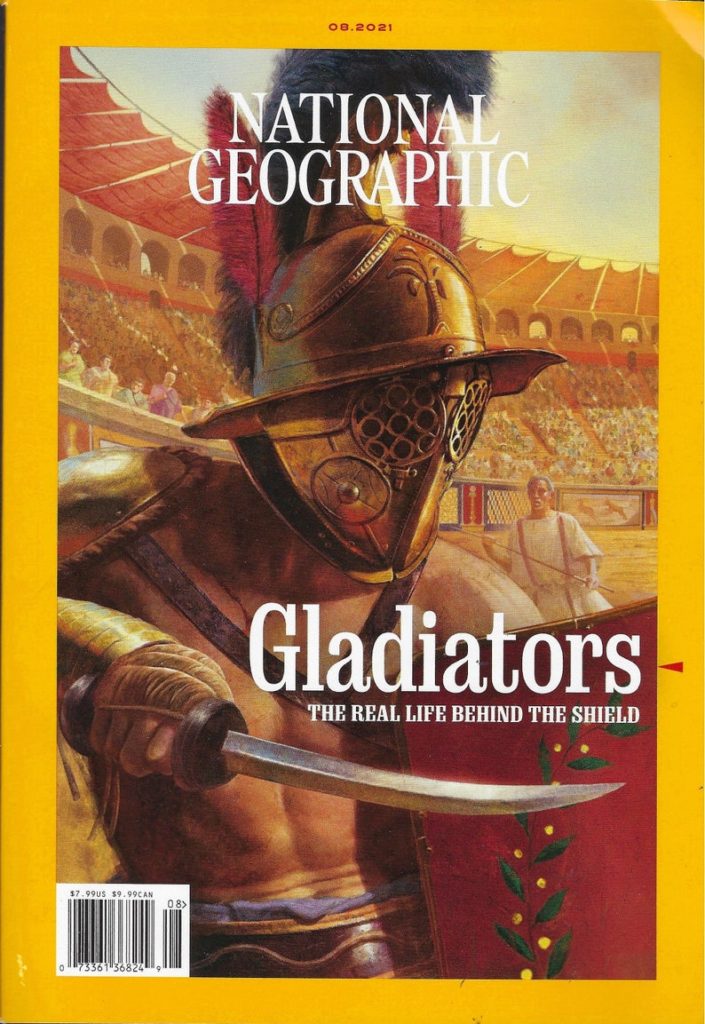This month’s cover story in National Geographic magazine is about gladiators. It’s a great cover with plenty of photos and recreated scenes to satisfy any devotee of the ancient sport.

It’s a short read that dispels many of the legendary beliefs about the gruesome “games,” as the Romans called these life & death competitions. “Games” in Latin is ludi (LOO-dee). It’s where “ludicrous” (laughable, playful) comes from. When you think about it, the “games” influenced much of our Western culture. The word arena is Latin for sand, the stuff spread on the amphitheater floor to absorb blood. Even the word amphitheater means “double-theater”: ancient theaters were semi-circles, the Romans joined two theaters to create 360-degree viewing. We also get our word circus (circle in Latin) from this ring of entertainment.
There is still a small controversy about “thumbs up”/”thumbs down.” Some say the Romans condemned a gladiator with thumbs down. However, they may have used a throat-cutting motion using a horizontal thumb across the gullet. Curiously, Nat Geo found an ancient mosaic that pictures a gladiator throwing in the towel by sticking his forefinger in the air. Who knew that quitting was an option?
These mosaics show referees in the arena with the gladiators – something you never see in the movies. In short, not all bouts in the arena were to the death. Gladiators were well-trained athletes who were bankrolled by wealthy Romans. No one wanted their investment dragged out of the arena with meat hooks. We moderns wouldn’t allow even the most rough and tumble games to be brawls – referees, time-outs, and victory by decision are not new developments in sports. Nat Geo noted in one mosaic that when a gladiator’s sword broke during combat, the ref stopped the match to replace the sword. Roman fair play!
The games were a part of Roman life for centuries, spreading to every Roman province as witnessed by the scores of mini-Colosseums that survive around the Mediterranean. These amphitheaters served many purposes. Public executions certainly took place with plenty of sadistic witnesses on hand; and prisoners of war were given a last chance at life in mock battles with each other or against wild beasts. Some amphitheaters could be flooded to stage mini-sea battles. Imagine the logistics and infrastructure to accomplish such a feat! Aqueducts had to be tapped to fill the arena with thousands of gallons of water; waterproof membranes had to be sown together to keep the water in; huge drains had to be in place to evacuate the basin. Archeologists have actually verified such technology existed in Rome. They have also found that amphitheaters could provide shade for the thousands of attendees using naval technology. Horizontal mast poles were anchored in an upper level of the Colosseum’s perimeter wall, every ten feet or so. Roman sailors attached canvas “sails” to the poles circling the whole amphitheater and hauled sections in or out depending on the track of the sun. (You can see the system pictured in the Nat Geo cover above, if you look closely.)
Another aspect of the games that encouraged Romans to treat gladiators well, was their individual popularity. Women swooned over them as rock stars – their glistening, muscular bodies armed with fearful weapons and elaborate armor. Men worshipped their physical prowess and courage. Accolades to gladiators were scrawled on walls in Pompeii. Gladiators could begin as slaves and achieve freedom and wealth over a few years. However, like modern boxers or NFL players, many gladiators suffered later for their brain-shaking careers.
This year, the caretakers of Rome’s Colosseum have reinstalled part of the ancient arena floor so tourists can get a gladiator’s view of his audience. Below the floor is a maze of rooms that held waiting gladiators and animals that would entertain the crowd above. A few years ago, a tiny room thought to be an elevator shaft, was just that. A rudimentary elevator was built that demonstrated how Roman stagehands were able to lift men, animals, and props to the arena. Such capability allowed the show managers to surprise the audience and perhaps shock the gladiators, or condemned victims, with a vicious lion now and then.
It must have been a real crowd pleaser! -JLM

Excellent piece about an excellent piece. I would add that mini-Colosseums continue to exist beyond the Mediterranean world—namely, in sports arenas everywhere. Google a picture of Harvard U’s athletic stadium. From a distance, you’d think you were in classical times.
Every day, in every way, all roads continue to lead to Rome.